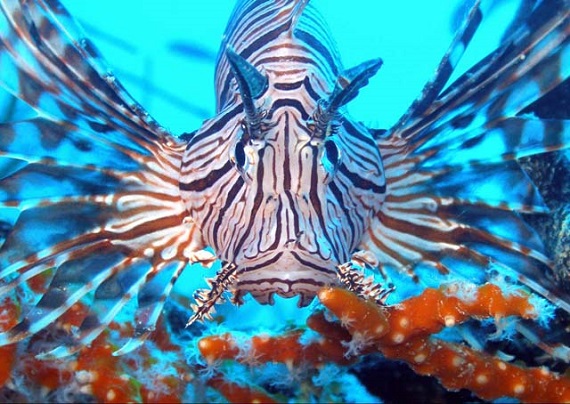In St Vincent and the Grenadines News. Clifton, Union Island, September 3rd, 2013 – Staff from six marine protected areas from Grenada and St Vincent and the Grenadines were trained in lionfish capture and handling during a recently-concluded Networking Meeting in Carriacou – Grenada from August 28th -30th, 2013.
The lionfish is an invasive species that was accidentally introduced to the Caribbean Sea and poses a threat to native reef fish. Their voracious appetites, coupled with their rapid reproductive rates, are making lionfish a major obstacle in marine conservation.
Their management is necessary for the health of the fisheries and tourism industries, which are the basis of livelihoods for many people in Grenada and St. Vincent and the Grenadines.
To help address this threat, rangers/wardens from the two countries had the opportunity to get hands-on experience in the capture and handling of lionfish. The marine protected areas that were represented from St. Vincent and the Grenadines were The Tobago Cays Marine Park, Mustique Marine Conservation Area and the South Coast Marine Conservation Area.
 On the Grenada end, they were the Sandy Island/Oyster Bed, Woburn/Clark’s Court and Moliniere-Beausjour Marine Protected Areas.
On the Grenada end, they were the Sandy Island/Oyster Bed, Woburn/Clark’s Court and Moliniere-Beausjour Marine Protected Areas. It was the third annual networking meeting for the marine protected areas of the Grenadines, a group which was originally established in 2011.
It was the third annual networking meeting for the marine protected areas of the Grenadines, a group which was originally established in 2011.
Other areas of focus during the three-day meeting were the sharing of best management practices for coral reef conservation, the importance of mangrove ecosystems and marine law enforcement.
On the final morning, some 20 local school children took part with the rangers/wardens in a series of outdoor marine education activities organized in association with the KIDO Foundation.
In addition, Woburn/Clark’s Court Marine Protected Area and the South Coast Marine Conservation Area became the newest members to join the Network of Marine Protected Areas of the Grenada Bank, pledging their willingness to collaborate with the network to ensure effective marine protected area management and to promote the conservation and sustainable use of marine and coastal resources.
This initiative is made possible by The Ocean Foundation and the Western Hemisphere Migratory Species Initiative of the Organization of American States.





